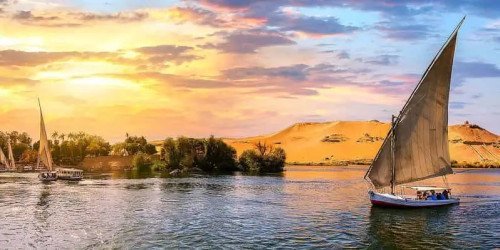About Nile River in Egypt
The Nile River In Egypt
The Nile River situated in the continent of Africa holds the distinction of being the longest river globally It traverses the land of Egypt from south to north bifurcating into two branches the Rashid Branch and the Damietta Branch which eventually flow into the Mediterranean Sea.
Spanning 6650 kilometers from its origins in Lake Tanganyika to its mouth at the Mediterranean Sea the Nile covers an area of 1.9 million square kilometers coursing through 11 countries Tanzania Kenya Zaire Burundi Rwanda Ethiopia Eritrea Uganda South Sudan Sudan and Egypt This magnificent journey can be experienced through various Egypt travel packages .
the Nile originates from Lake Victoria navigating through drops and slopes propelling itself upwards or downwards until it reaches its natural course. Renowned as the lifeblood of Egypt the Nile River sustains life fertility and development for the region. As the Greek historian Herodotus famously noted Egypt is the gift of the Nile emphasizing its pivotal role in Egyptian life Moreover the Nile serves as the foundation for Nilotic tourism attracting tourists who embark on Egypt tours to explore Egypt is northern and southern regions.
The river derives its name Nile from the Greek term Neilos signifying its connection to ancient Greek culture. Additionally it is referred to in Greek as Aigyptos contributing to the European terminology for Egypt in Latin as Aegyptus.
The Nile's journey begins in Khartoum Sudan where it converges with its two main tributaries the White Nile originating from the Lakes Plateau (Lake Victoria) and the Blue Nile from Ethiopia (Lake Tana).
The White Nile's source is complemented by the River Luveronza in Burundi which serves as the southernmost spring of the Nile. After a 690 kilometer journey, the river joins Lake Victoria the primary source of the White Nile is waters. Meanwhile Lake Victoria, located at the convergence of Uganda Tanzania, and Kenya serves as the world's second-largest freshwater lake boasting an area of 67000 square kilometers and an average depth of 40 meters.
Emerging from Lake Victoria at Jinja the Nile assumes the name Victoria Nile before progressing 70 kilometers to Lake Kyoga. Exiting Lake Kyoga near Masindi, the river cascades through the Morchanson Falls covering a distance of 500 kilometers before reaching Lake Albert. Lake Albert spanning approximately 5300 square kilometers is fed by the Smilecki River originating from Lake Edward.
Upon departing Lake Albert the Nile is identified as the Albert Nile until it enters South Sudan at Nimoli Passing through the Falls of Fula it assumes the title of Bahr al Jabal subsequently meeting the Aswa River and traversing the dense swamps of the dams area After converging with the Sobat River originating from the Abyssinian plateau the Nile resumes its northerly trajectory covering a distance of 720 kilometers before reaching Sudan is capital Khartoum
The Blue Nile contributes 80-85% of the water to the Nile primarily during the summer rains on the Abyssinian plateau, known as the Nile flood. However this inundation does not occur throughout the year Originating from Lake Tana in the Ethiopian highlands the Blue Nile receives only 7% of its water on average with the remainder sourced from various tributaries. Upon crossing the Ethiopian Sudanese border the river is christened the Blue Nile continuing its course for 1400 kilometers until it meets the White Nile in Khartoum is Al-Muqrin area forming the Nile as we know it. From there it flows through Egypt is lands to its final destination the Mediterranean Sea.
Visitors can embark on luxury Nile cruises to witness the Nile is grandeur and explore its historical significance. For those seeking more budget friendly options cheap Nile cruises provide a fantastic way to experience this majestic river.
Nile Confluence
After the confluence of the White and Blue Niles at the Muqrin of Khartoum to form the Nile River there remains only one tributary to feed the Nile with water before entering Egypt which is the Atbara River with a course of approximately 800 kilometers (500 miles). This river also originates from the Ethiopian highlands north of Lake Tana, and connects to the Nile at a distance of 300 kilometers (200 miles) after Khartoum city.
North of Khartoum the Nile passes through six waterfalls with the sixth waterfall at Al Sablouqa (north of Khartoum) until the Aswan waterfall in Egypt. It alters its course as the Nile bends southwest near Abu Hamad city before returning to its original path north near Al Dabba City. This curved part is known as The Great Bend of the Nile.
After returning to its original course the Nile crosses the Sudanese-Egyptian border and continues its course inside Egypt until it reaches Lake Nasser an artificial lake located behind the High Dam. In 1998 some parts of this lake separated westward with the Western Desert to form the Toshka lakes. Returning to its original course in Lake Nasser cruises the Nile exits the lake and heads north until it reaches the Mediterranean Sea. Along this path a part of the river branches off at Assiut known as Bahr Youssef and continues until it reaches Fayyoum.
For those interested in comprehensive travel experiences Egypt travel packages often include tours to these significant locations along the Nile.
The Nile River reaches the far north of Egypt splitting into two branches the Damietta branch in the east and the Rashid branch in the west, enclosing between them the Nile Delta considered at the top of the list of deltas in the world. Eventually the Nile flows through these two branches into the Mediterranean Sea ending its long journey from central East Africa to the north. The cities that the Nile River passes through after the confluence include Shendi Al Matma Al Damir Atbara Abu Hamad ending with Halfa before entering Egypt.
Nile Water
The Nile receives its water from several sources:
- The Blue Nile contributes 59% of the revenue.
- The Sobat River contributes 14%.
- The Atbara River contributes 13%.
- The Bahr al-Jabal contributes 14%.
These percentages change during the flood season, with the Blue Nile contributing 68%, the Atbara River contributing 22%, and 5% each from Sobat and Bahr al-Jabal. The relatively small contribution of the White Nile is due to evaporation losses in the dam area.
Silt
The Nile carries about 110 million tons of silt annually, most of which comes from the Abyssinian plateau. This silt has a significant impact on the basin countries, renewing soil fertility in some areas while reducing the storage capacity of reservoirs and dams along the Nile's course.
Nile Flood
Civilizations that began on the Nile's banks relied primarily on agriculture, especially in Sudan and Egypt. Therefore, Nile floods were of great importance in ancient Egyptian and Nubian life. Floods occurred periodically in the summer.
In Pharaonic Egypt, floods were associated with semi-sacred rituals, with celebrations held to rejoice in the flood's arrival. These celebrations were recorded through carvings on temple walls, tombs, and pyramids, demonstrating the reverence for the flood.
In Islamic Egypt, rulers also paid attention to the flood, designing a "Nileometer" to accurately measure it. This scale still exists today on "Rawda Island" in Cairo.
In modern times, in the late 1980s, Nile Basin countries experienced drought due to weak Nile floods, leading to water shortages and major famines in both Sudan and Ethiopia. However, Egypt did not suffer from these problems due to water storage in Lake Nasser behind the High Dam.
Economic Importance
1. The Nile Basin offers unique geographical diversity, starting from highlands in the south and gradually decreasing in height until reaching wide plains in the far north. Therefore, the Nile River flows from south to north based on the land slope.
2. The Nile is of great importance to the economies of Nile Basin countries, especially in agriculture. Farmers depend on its water to irrigate crops like cotton, wheat, sugarcane, dates, legumes, and citrus fruits.
3. In fishing, fishermen depend on the Nile's indigenous fish, a favorite food for many people in these countries.
4. The Nile is famous for its diverse aquatic life, including the Nile crocodile, which inhabits most of its course.
5. In tourism, particularly in Sudan and Egypt, one type of tourism relies on the Nile, known as "Nile Tourism." Tourists and visitors travel by felucca boats between the third and fourth dams in northern Sudan, and between Juba and Kosti in southern Sudan, as well as Giza, Minya, Sohag, Qena, Luxor, and Aswan in Egypt. Luxury Nile cruises are a popular way to experience this.
History
Due to the immense potential provided by the Nile River, it was coveted by colonial powers in the 19th century.
During that period, European countries controlled Nile Basin countries. Britain tightened its grip on Egypt, Sudan, Uganda, and Kenya, while Germany took control of Tanzania, Rwanda, and Burundi. Belgium controlled the Democratic Republic of the Congo, then known as Zaire.
After World War I (1914-1918), the German Empire was divided between Britain and Belgium. England acquired Tanzania, while Belgium got Rwanda and Burundi, leaving Ethiopia as an independent state.
With the end of British control over Egypt and Sudan in the 1950s, the Nile Waters Agreement was signed in 1959 to divide Nile waters.
Discover everything you desire in Egypt, guided by our knowledgeable Egyptologists. Our meticulously planned tours, designed like Egypt Private Tours, guarantee an unforgettable experience exploring the wonders of Egypt
 English
English
 Español
Español
 Chinese
Chinese
 français
français
 português
português
 Italian
Italian
 Russian
Russian
 Czech
Czech
 Deutsch
Deutsch
 Japanese
Japanese









